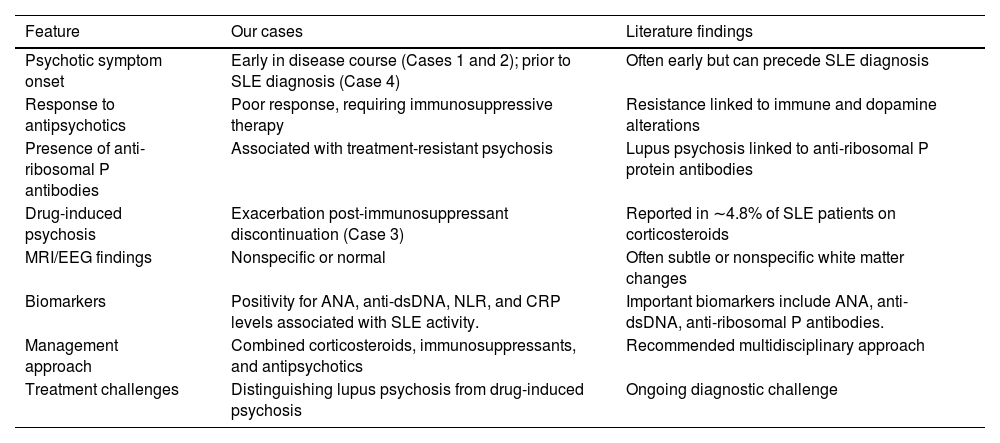Systemic lupus erythematosus (SLE) is an autoimmune disease causing neuropsychiatric symptoms, including lupus psychosis. This review examines the presentation and treatment resistance of lupus psychosis through a case series and comparison with existing literature. Our case series includes four patients with lupus psychosis. The first two cases showed psychotic symptoms as the primary manifestation of SLE, resistant to antipsychotic treatment. Literature suggests that this resistance may be due to immunological factors, such as anti-ribosomal P protein antibodies, and neurotransmitter alterations. The third case involved psychosis exacerbated by discontinuation of immunosuppressive therapy. The fourth case presented psychosis years before an SLE diagnosis, highlighting diagnostic challenges. MRI and EEG findings were generally nonspecific. Treatments included high-dose corticosteroids, immunosuppressive agents, and antipsychotic medications tailored to individual needs. Lupus psychosis is challenging to diagnose and treat due to its complex pathogenesis and potential for treatment resistance. Our cases highlight the need for considering SLE in patients with treatment-resistant psychosis and the importance of individualized treatment strategies.
El lupus eritematoso sistémico (LES) es una enfermedad autoinmune que causa síntomas neuropsiquiátricos, incluida la psicosis lúpica. Esta revisión examina la presentación y la resistencia al tratamiento de la psicosis lúpica a través de una serie de casos y su comparación con la literatura existente. Nuestra serie de casos incluye 4 pacientes con psicosis lúpica. Los 2 primeros casos mostraron síntomas psicóticos como la manifestación primaria del LES, resistentes al tratamiento antipsicótico. La literatura evidencia que esta resistencia puede deberse a factores inmunológicos, como los anticuerpos antiproteína P ribosomal, y alteraciones de neurotransmisores. El tercer caso involucró una psicosis exacerbada por la interrupción de la terapia inmunosupresora. El cuarto caso presentó psicosis años antes de un diagnóstico de LES, destacando los desafíos diagnósticos. Los hallazgos de RM y EEG fueron generalmente inespecíficos. Los tratamientos incluyeron corticosteroides en altas dosis, agentes inmunosupresores y medicamentos antipsicóticos adaptados a las necesidades individuales. La psicosis lúpica es un desafío diagnóstico y terapéutico debido a su patogénesis compleja y su potencial de resistencia al tratamiento. Nuestros casos destacan la necesidad de considerar el LES en pacientes con psicosis resistente al tratamiento y la importancia de estrategias de tratamiento individualizadas.







